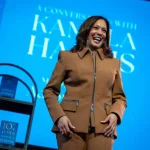
The 2024 election is just days away.
Media coverage, especially on social platforms, is rampant with fake news and misinformation, making it challenging to distinguish between what is real and what is misinformation. Although opinion polls are far from flawless, they offer a quantitative glimpse into the electoral landscape.
I rely on the most trustworthy pollsters to gauge the electorate.
According to Rasmussen Reports, “One week prior to Election Day, former President Donald Trump holds a two-point advantage over Vice President Kamala Harris in the most recent daily tracking poll for the 2024 presidential election.”
This indicates that Trump could win the popular vote.
The last Republican presidential candidate to achieve this was George W. Bush, twenty years ago in 2004.
<img alt="Trump looking up, ai" captext="The Last Refuge, by permission” src=”https://conservativenewsbriefing.com/wp-content/uploads/2024/11/with-less-than-a-week-until-the-election-what-do-the-polls-say.jpg” width=”600″>
Screenshot The Last Refuge // by permission
If Trump prevails next week, winning the popular vote may silence some of the anticipated Democratic butt-hurt labeling Trump an “illegitimate president.”
However, the national popular vote does not establish the winner, a lesson that Hillary Clinton learned in 2016.
The next occupant of the White House is determined by the Electoral College, which consists of 50 individual state elections.
According to AtlasIntel, the most reliable pollster from the 2020 election, Trump is forecasted to secure victory with 296 electoral votes, while Harris is expected to receive 242. This isn’t a landslide, but it is a solid win.
For a third opinion, Nate Silver has Harris up by a point nationally in his model. But the trend lines nationally and in battleground states are rising for Trump and falling for Harris.
Most states are firmly aligned as red or blue, Republican or Democrat, respectively, and are unlikely to change. As in previous elections, just a few key battleground states will decide the outcome.
RealClearPolitics presents the average polling results from the seven battleground states, providing perspective on the election in relation to the Electoral College. In these states, Trump leads by +1.0.
Looking at specific states, Arizona is Trump +2.5, Nevada is Trump +0.5, Wisconsin is Harris +0.2, Michigan is Harris +0.4, Pennsylvania is Trump +0.8, North Carolina is Trump +1.0, and Georgia is Trump +2.4.
Trump needs the majority, though not necessarily all, of these states to prevail on Nov. 5. While it’s possible to speculate numerous combinations and permutations of these states, the current data, just a week before Election Day, favors Trump.
Since this article started with national polls, let’s look back at previous elections and compare national polls. The RealClearPolitics national average from five days prior to the upcoming election indicates Donald Trump with a +0.4 lead. Though it’s a slight advantage, where did candidate Trump stand four and eight years ago?
In 2020, just five days before the election, the national average indicated Joe Biden +7.4, a race he narrowly secured, setting aside election chicanery.
In 2016, just a week before the election, the RCP national average showed Hillary Clinton at +1.3. We all remember the outcome of that race.
Trump’s national lead of +0.4 might appear slim, but as Newsweek states, “Republican nominee Donald Trump is slightly ahead of Democratic Vice President Kamala Harris in the average of national polls by aggregator RealClearPolling for the first time since August.”
Trends hold significance, especially during the final days approaching the election.
Crowd size and enthusiasm at political rallies are harder to measure, yet both show support for Trump. An example was his massive recent gathering at Madison Square Garden in overwhelmingly Democratic New York City.
Then there are the snapshots and soundbites. From Trump serving fries at McDonald’s a few weeks ago to giving a press conference from a garbage truck a few days ago, Trump is a master at trolling Democrats and the media, throwing their lies and disparagement back in their faces.
Finally, let’s examine betting odds. While opinion polls capture voter desires, betting odds show what bettors anticipate will occur, focusing on their expectations rather than aspirations.
RealClearPolitics’ most recent betting odds show Trump with a 63% likelihood of winning the election, while Harris trails at just 36%.
Voting is only part of the equation. As Joseph Stalin said, “Those who vote decide nothing. Those who count the votes decide everything.” Election integrity is a key issue in this election, with significant differences of opinion on this issue between the two parties.
For instance, in Colorado, “Secretary of State Jena Griswold (Democrat) acknowledges that fraudulent ballots were included in this election.” Additionally, “Passwords for election equipment were made public on the Secretary of State’s official website, which were then quietly corrected without any public notice or remedy.”
In Pennsylvania the Lancaster County Board of Elections found that “Up to 2,500 fraudulent voter registration applications were dropped off in two batches shortly before the deadline.”
A drop box in Vancouver, Washington, was ignited, damaging 475 ballots.
Why can’t America get it right? India counted 640 million votes in a single day. Maricopa County, Arizona, with a population of about 4 million, less than 1% of India’s, predicts that ballots may take two weeks to count.
Now we learn that electoral officials have said that some voting machines are experiencing “programming issues” on a nationwide basis. We had “safe and effective” COVID vaccines. Then we had “safe and secure” voting machines.
In deciding not to endorse either presidential candidate, Washington Post owner Jeff Bezos highlighted a crucial point: “Voting machines must fulfill two criteria. They must accurately count the votes, and people must trust that they do. The second criterion is not only distinct but equally vital as the first.”
The reality and the perception of that reality. What are voters’ views on our “safe and secure” elections?
It’s far from just voting machines that are altering perceptions.
Rasmussen Reports found, “Most voters don’t believe state officials have done enough to prevent voting by illegal immigrants or to stop outside groups from interfering in elections.”
Contrary to the assertions made by Democrats and the media regarding Donald Trump, the genuine “threat to democracy” is election integrity. If voters lose trust in the electoral process, how does America differ from Venezuela, Cuba, or the former Soviet Union?
Are presidents elected or selected? What happened to Abraham Lincoln’s government “of the people, by the people, for the people”?
Following the credible allegations of electoral fraud in 2020, we can only hope that Trump and his team have implemented steps to avoid a recurrence in 2024. Failing to do so would truly fit the definition of insanity.
I believe Trump is astute enough not to repeat the same approach while anticipating a different outcome four years later. It is inconceivable that Trump is not well aware of the forces against him, from the corporate media to the administrative state ruling class, which views Trump as an existential threat, and that he and his campaign are well prepared.
But my wishful thinking and observations may be far off the mark. As Trump would say, “We’ll see what happens.”
Opinion polls and betting odds favor Trump. The final poll takes place on Nov. 5, and we hope the outcome accurately represents the American voters’ wishes.
Brian C. Joondeph, M.D., is a physician and writer. Follow me on Twitter @retinaldoctor, Substack Dr. Brian’s Substack, Truth Social @BrianJoondeph, LinkedIn @Brian Joondeph, and Email [email protected].






